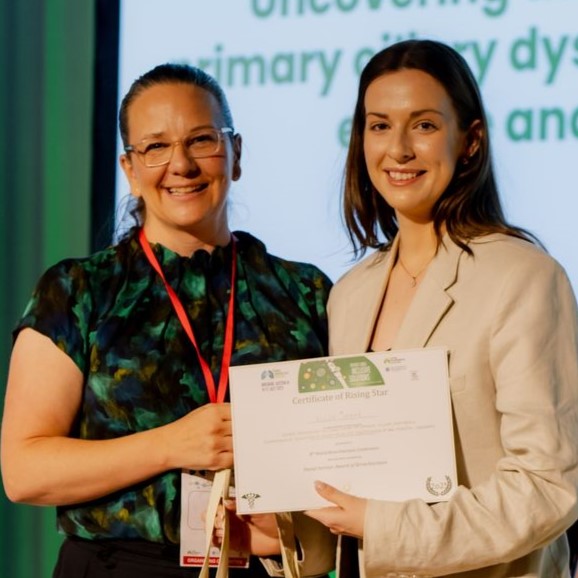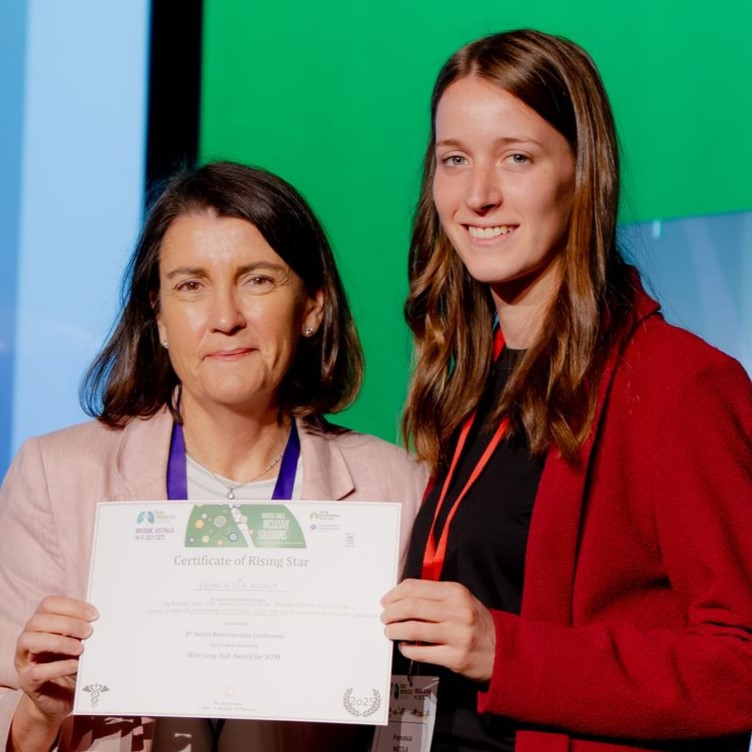Rising Star Winners

- Ellie Maas
Session: Wednesday, 16th July 11.30 β 11.45
Abstract Title: Uncovering the genetic landscape of primary ciliary dyskinesia: insights from exome analysis of a large cohort
Affiliation: University of Queensland
Dr Ellie Maas comes from a regional town in south-east Queensland, Australia. She has a vested interest in genetics, as she worked as a neurogenetics research assistant, before pursuing her PhD in dermatological genetics with the Dermatology Research Centre at the University of Queensland. Ellieβs research focuses on identifying genotype-phenotype correlations in hereditary cancers which includes melanoma and primary ciliary dyskinesia. Upon submission of her PhD, Ellie was offered a position in the UQ Doctor of Medicine (MD) program. She is currently in her second year of study while working part-time as a postdoctoral researcher with the UQ Integrating Genomics into Medicine group.
Exome sequencing of an Australian primary ciliary dyskinesia cohort (PCD) (n=98) identified causal variants in 47%, mainly in DNAH5 and DNAH11. Gene discovery analysis of unsolved cases revealed AK8 and CFTR play a role in PCD. This study broadens the PCD phenotypic spectrum, clarifies clinical diagnoses, and uncovered emerging gene-disease relationships.

- Francesca Nicola
Session: Tuesday, 15th July 17.00 β 17.15
Abstract Title: Unraveling the pathogenicity of Mycobacterium abscessus in cystic fibrosis pulmonary epithelial cells and mouse models of respiratory infection
Affiliation: San Raffaele Scientific Institute
Francesca Nicola, PhD student in Molecular Medicine at Vita-Salute San Raffaele University in Milan, Italy. I am currently working in the Emerging Bacterial Pathogens Unit, led by Dr. Daniela Cirillo, under the supervision of Dr. Nicola Ivan Lorè. My research focuses on host-pathogen interactions at the mucosal level, using both in vitro and in vivo models. I apply omics approaches to gain a deeper understanding of these complex relationships, with a particular emphasis on nontuberculous mycobacteria, especially Mycobacterium abscessus.
Nontuberculous mycobacteria (NTM) are environmental bacteria that can cause chronic lung diseases like bronchiectasis. Mycobacterium abscessus (Mabs), a highly drug-resistant NTM, poses a major clinical challenge. This study investigates how Mabs modulates immune and inflammatory responses during infection. Findings reveal that Mabs morphotypes influence lung epithelial responses and impact disease severity.

- Lele Wang
Session: Monday 14th July 16.45 β 17.00
Abstract Title: Mapping Hemoptysis Risk in Bronchiectasis: A Real-World Snapshot from BE-China
Affiliation: Shanghai Pulmonary Hospital
Lele Wang is a PhD researcher at the School of Medicine, Tongji University, under the supervision of Professor Jin-Fu Xu. She completed her undergraduate studies in Clinical Medicine at Tongji University in 2021 and subsequently entered a direct PhD program. Her doctoral research focuses on the pathophysiological mechanisms of Pseudomonas aeruginosa infection in bronchiectasis patients, particularly the role of gut microbiota in shaping pulmonary immune responses. Her work also includes evidence-based investigations into the risk factors for hemoptysis in bronchiectasis. Her first-author publications include Science Translational Medicine, Clinical Microbiology and Infection, Respiratory Research, among others, along with a co-first author paper in MedComm.
Using data from the BE-China Registry (n = 9,954), this study found that 22.3% of bronchiectasis patients experienced hemoptysis. Risk factors included longer disease duration, frequent exacerbations, P. aeruginosa infection, liver disease, post-tuberculosis etiology, and low-income region. Protective factors were sputum production and non-infectious causes. Findings highlight the need for etiology-based risk assessment and targeted interventions.

- Ao Wen Zhuang
Session: Wednesday, 16th July 14.40 β 14.55
Abstract Title: Redirecting the mucus cells to clear off the muco-obstruction
Affiliation: The University of Melbourne
Dr Aowen Zhuang is an early mid-career Research Fellow at the Centre for Lung Health Research in the Department of Biochemistry and Pharmacology, the University of Melbourne.Β He is passionate in better understanding the molecular biology that underpins the shift from pre-disease to established progressive disease. His current work contributes to the drug development of a TLR2/6 pan-antiviral agonist, splice-switching oligonucleotides targeting RAGE and new inhaled JAG-1 blockers for muco-obstructive disease and contributes to the EMCR leadership roles within the Cure Asthma Initiative.
Mucus hypersecretion and/or impaired mucociliary clearance is a pathogenic feature of many chronic muco-obstructive lung diseases. Jagged-1, acting predominantly through Notch2, controls the delicate balance of secretory club cells and ciliated cells. Here we characterize the inhalable Jagged-1 targeting tool Anticalin, PRS-400, dose-dependently suppressed JAG1-Notch signalling, prevented and reversed goblet cell metaplasia and mucus hypersecretion, epithelial remodelling and restored FOXJ1 ciliated cells in IL-13, house dust mite βasthmaβ and bENAC-tg βcystic fibrosisβ murine models.
Rising Star Candidates

Laura Ann Cooper
Session: Wednesday, 16th July 09.10 β 09.25
Abstract Title: Impact of physiotherapy-led airway clearance services on healthcare usage
Affiliation: Southern Adelaide Local Health Network
Laura Cooper is an Advanced Respiratory Physiotherapy Clinician working within the Out of Hospital Respiratory Services in the Southern Adelaide Local Health Network. Laura has worked in the clinical area of cardiorespiratory physiotherapy for 23 years. She has a particular interest in airway clearance services and their models of care and has completed a Masters of Research in this area at the University of South Australia in 2021. Laura is currently furthering her field of research in this space as a PhD candidate.
Laura currently manages a team of allied health and nursing clinicians that provide community and home-based rehabilitation style hospital avoidance programs to people with chronic lung conditions and neuromuscular disease in the south of Adelaide. Her area of clinical interest is providing community-based outpatient airway clearance intervention to people with chronic mucus hypersecretion.
Interrupted time series analysis to measure the impact of attendance at a community-based physiotherapy-led airway clearance service on healthcare usage. Significant reductions were seen in the number of respiratory-related hospital admissions, Emergency Department presentations, length of stay and associated healthcare costs following initial airway clearance session.

Robert Flowers
Session: Tuesday, 15th July, 09.25 β 09.40
Abstract Title: Urban Inequities in Bronchiectasis: How Race, Ethnicity, and Socioeconomic Status Shape Outcomes
Affiliation: NYU Langone Health
New York University Grossman School of Medicine (New York, NY)
07/2022 β 06/2025 Fellow in Pulmonary and Critical Care Medicine
University of Miami / VA Medical Center (Miami, FL)
07/2021 β 06/2022 Chief Medical Resident in Internal Medicine
University of Miami / Jackson Memorial Hospital (Miami, FL)
07/2018 β 06/2021 Resident in Internal Medicine
Tulane University School of Medicine (New Orleans, LA)
09/2014 β 05/2018 Doctor of Medicine (MD)
Tulane School of Public Health & Tropical Medicine (New Orleans, LA)
09/2012 β 05/2014 Master of Public Health (MPH)
Emory University (Atlanta, GA)
09/2007 β 05/2011 Bachelor of Arts (BA) in Anthropology
Patients were enrolled in a bronchiectasis registry from Bellevue Hospital in New York City from 2021 to 2025 (n=58). Hispanic patients had the lowest hospitalization rates for respiratory illness, but the highest use of government-assisted insurance. Black patients lived in neighborhoods with higher poverty and unemployment, and multivariable models showed roughly three-fold higher hospitalization risk for Asian and Black patients versus Hispanic patients. These findings expose structural inequities and underscore the need for U.S. bronchiectasis research to recruit more under-represented minorities, broadening evidence beyond historically homogenous cohorts.

Koji Furuuchi
Session: Tuesday, 15th July 14.20 β 14.35Abstract Title: Airway epithelial gene expression profiles reflect disease phenotypes in Mycobacterium avium Complex Lung Disease
Affiliation: Fukujuji Hospital
April 2020 β Present (Concurrent)
Researcher, Department of Pathophysiology and Host Defense, The Research Institute of Tuberculosis, Japan Anti-Tuberculosis Association
April 2018 β Present (Main)
Clinical fellow, Respiratory Disease Center, Fukujuji Hospital, Japan Anti-Tuberculosis Association
April 2014 β March 2018
Senior resident, Department of Respiratory Medicine, Ohara Healthcare Foundation, Kurashiki Central Hospital
April 2012 β March 2014
Junior resident, Kobe City Nishi-Kobe Medical Center
SLC26A4, encoding the anion exchanger pendrin, was upregulated in airway epithelial cells (AECs) from patients with Mycobacterium avium complex lung disease (MAC-LD), together with immune-related genes. Correlation analyses suggest that AEC gene expression profiles are associated with clinical phenotypes and may contribute to MAC-LD pathogenesis.

Rebecca Hull
Session: Wednesday, 16th July 09.30 β 09.45
Abstract Title: Airway Interleukin-7 is a biomarker of exacerbation risk in patients with Pseudomonas aeruginosa infection in bronchiectasis
Affiliation: University of Dundee
Rebecca Hull is a postdoctoral researcher in the respiratory research group at the University of Dundee. She completed her PhD at the University of Sheffield, before moving to Dundee to carryout work aiming to identify factors which predict bronchiectasis patient responses to Pseudomonas targeting antibiotics and responses to novel therapies.
We identified reduced airway IL-7 as a reproducible biomarker of increased exacerbation risk in people with P. aeruginosa infection in bronchiectasis. IL-7 levels were linked to reduced neutrophilic inflammation, increased antimicrobial proteins, enhanced microbiome diversity and higher commensal abundance. Patients had lower IL-7 in high bacterial load infections which suggests a potentially targetable immunomodulatory pathway.

Merete Long
Session: Tuesday, 15th July 11.30 β 11.45
Abstract Title: Results from the GREAT-2 phase II randomised placebo-controlled trial of the bispecific monoclonal antibody gremubamab targeting Pseudomonas aeruginosa in people with bronchiectasis
Affiliation: University of Dundee
Dr Merete Long was named one of the best young scientists in her field for her work in understanding why some people continue to suffer after being infected with Covid-19.
She was awarded the British Association of Lung Research Early Career Investigator Award at the British Thoracic Society Winter Meeting after delivering a presentation on her research into neutrophils, which are white blood cells that act as the immune systemβs first line of defence, and the role they play in Covid-19 infection.
The postdoctoral researcherβs study showed changes within neutrophils were linked to delayed recovery and highlighted neutrophils as potential therapeutic targets in long Covid.

Lidia Perea
Session: Wednesday, 16th July 11.30 β 11.45
Abstract Title: Airway CC16, bronchial infection and disease severity in bronchiectasis
Affiliation: Biomedical Research Institute August Pi i Sunyer (IDIBAPS)
Lidia Perea is an early-career researcher focused on the immunology of bronchial infections in Bronchiectasis in the Biomedical Research Institute August Pi i Sunyer (IDIBAPS) in Barcelona, Spain. In 2016, she started her PhD in the Sant Pau Biomedical Research Institute in Barcelona focused on Bronchiectasis and COPD. Once she obtained her PhD in 2020, she received a Long-Term European Respiratory Society (ERS) Fellowship for a 1-year international postdoctoral stay to join the research group led by Prof. James D Chalmers at the University of Dundee, in Scotland. During that year, she developed a project focused on the role of IL-1beta on Bronchiectasis, with a special interest on the bronchial epithelium. Currently, she has a postdoctoral researcher position at the IDIBAPS supported by the National Institute of Health Carlos III (ISCIII) and she is working on the role of the innate and adaptive immune response in Bronchiectasis. Throughout her research career, she has published a total of 40 works, being first author in 9 of them, with 839 total citations and a Scopus H-index 17. She is also part of the CRC BEAT-PCD supported by ERS.
Pulmonary and systemic levels of the immunomodulatory protein club cell secretory protein (CC16) were measured in clinically stable non-cystic fibrosis bronchiectasis patients. Low sputum CC16 levels were related to disease severity, bronchial infection, airflow limitation and airway inflammation, but this was not reflected in the systemic compartment, providing evidence of altered tissue remodelling mechanisms in bronchiectasis.

Jack Roberts
Session: Wednesday, 16th July 11.30 β 11.45
Abstract Title: Developing a bronchiectasis child-specific QoL instrument (BC-QoL)
Affiliation: Australian Centre for Health Services Innovation | Queensland University of Technology
Jack Roberts is a Research Fellow and PhD candidate at AusHSI. His recently submitted PhD contributes to better understanding the costs of bronchiectasis and developing new instruments for measuring health utility and health-related quality of life in children with bronchiectasis and their families.
Jack has research interests in health economics and improving and understanding the optimal methodology for valuing health states for use in cost utility analyses. Jack is also interested in consumer preferences for healthcare, research translation and improving health care efficiency. Jack is experienced in conducting discrete choice experiments, psychometric analysis, and in the analysis of linked data from large clinical registries, Medicare, and the pharmaceutical benefit scheme.
Quality of life (QoL) is the highest prioritized outcome by children with bronchiectasis and their parents but until now no validated QoL instrument specific for child bronchiectasis has existed. Our newly developed BC-QoL consists of 23 items covering 3 domains and has evidence demonstrating its validity and reliability in children with bronchiectasis. BC-QoL is a specific, sensitive and valid patient-reported outcome measure that can be used in evaluating quality of life in children with bronchiectasis in intervention and observational studies.
Guidelines
Online submission
In order to participate in the selection process, please submit before April 13, 2025.
- Submit your work through the website selecting the section βCall for Rising Stars.β
- Select the topic among the list, follow the instructions and complete your submission according to the rules.
- Upload a Full academic curriculum including publications and / or poster presentations made in the past.
- Upload a COI disclosure form.
General rules

"As a young researcher, participating in the Rising Star program of the World Bronchiectasis Conference provided a unique opportunity to connect with leading experts across diverse scientific fields and share my research on an international stage. This experience not only enhanced my visibility in the academic community but also opened doors to new collaborations. I recommend this program to other young researchers - it is a great opportunity to gain valuable feedback, expand professional networks, and be inspired by groundbreaking work in the field."
Testimonial from Dr. Basil Wicki, University of Basel, Department of Biomedicine β WBC 2024 Rising Star Award Winner
Zina Alfahl
Rising Star Winner (Bronchiectasis)
School of Pharmacy, Queenβs University Belfast (United Kingdom)
Title:
Sputum microbiome and clinical outcome measures in bronchiectasis: Data from the BRONCH UK Study
Summary:
Patients with bronchiectasis suffer from recurrent pulmonary exacerbations which lead to progressive loss of lung function, reduced quality of life and increased morbidity and mortality. Bacterial infections are the major cause of exacerbations due to the presence of one or more pathogens; therefore, the characterisation of the airway microbiome may improve our understanding of the natural history of bronchiectasis. In this study, we investigated the changes in bacterial community composition in sputum during clinical stability and following antibiotic treatment for pulmonary exacerbation. In addition, we investigated the relationship between main microbiome ecological indices and clinical outcome measures. Results showed that bacterial community composition was stable during periods of clinical stability and did not change following antibiotic treatment of a pulmonary exacerbation. Furthermore, no association was observed between changes in the main ecological indices and clinical outcome measures.
Jelmer Raaijmakers
Rising Star Winner (NTM -PD)
Radboud University Medical Center, Nijmegen (The Netherlands)
Title:
Rifampicin has no clear role in the standard regimen for M. avium complex lung disease β A hollow-fibre study with genome-wide transcriptional analysis.
Summary:
Mycobacterium avium complex (MAC) bacteria are the most frequent causative agents of nontuberculous mycobacterial pulmonary disease (NTM-PD) worldwide. Rifampicin is currently recommended for the treatment of MAC-PD alongside azithromycin and ethambutol. Rifampicin has poor in vitro activity against MAC, but is thought to prevent the emergence of macrolide resistance. We evaluated the contribution of rifampicin within the standard therapy of MAC-PD in an intracellular hollow-fibre model. Rifampicin did not add to the antimycobacterial effect to a regimen of azithromycin and ethambutol and it did not add to suppression of the emergence of macrolide resistance. In addition, to study the differences in adaptation to each treatment regimen, we performed RNA sequencing of the bacterial population over time. RNA sequencing showed that the addition of rifampicin does not greatly alter gene transcription in comparison to the 2-drug regimen. We believe that the similar transcriptomic profile in the two arms is driven by the presence of both azithromycin and host cells, both strongly influencing transcription and likely dominating the stress response with little-to-no additional effect of rifampicin. The additive effect of rifampicin in the treatment regimen is thus questionable, particularly in nodular-bronchiectatic MAC-PD.




